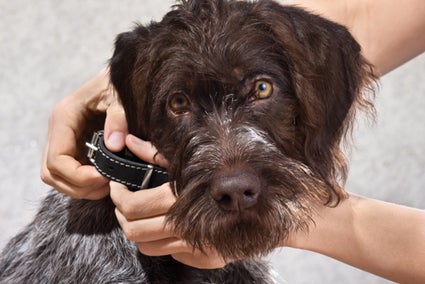Choosing the Right Collar to Keep Your Dog from Pulling

Dogs absolutely love to go on walks but sometimes their excitement gets the better of them. If you have a larger dog, it might sometimes feel like he’s walking you instead of the other way around. Rather than struggling with your dog every time you go for a walk, consider whether using a different kind of collar might solve your problems. Keep reading to learn about different types of collars that can help to improve leash etiquette in dogs.
Types of Collars for Dogs that Pull
Dogs of all breeds and sizes can develop a tendency to pull on the leash, though this is a bigger problem for large and giant breeds – if a small-breed dog pulls on the leash, it is easy to maintain control. If you have a larger or a particularly stubborn dog who makes walking difficult for you, consider whether switching to a different collar might help solve the problem. Here is an overview of some of the types of collars that are helpful for dogs that pull:
- Slip Chain Collar – Also known as a choke collar, slip chain collars consist of metal chains with a ring on either end. You pass the chain through one of the rings to create a loop then place it over your dog’s head and attach the leash. When your dog pulls, the collar tightens to provide short correction – the harder he pulls, the tighter the collar gets.
- Prong Collar – Similar in concept to the slip chain collar, a prong collar is made up of metal links with blunted prongs. The collar tightens around your dog’s neck when he pulls on the leash, but it has limited constriction so it will pinch your dog’s skin to cause discomfort but not injury.
- Head Collar – This kind of collar looks similar to a muzzle but it doesn’t actually keep your dog from opening his mouth. A head collar has one strap that goes around your dog’s muzzle and another around his head – you connect your leash to the strap around the muzzle so when you pull on the leash, it forces the dog’s head to turn so you can lead him easily.
- Front Clip Harness – Though technically not a type of collar, a front clip harness has two straps – one that fits around your dog’s body and one around his chest. This harness is different from the standard step-in harness because they clip in the front, not between your dog’s shoulder blades. A front clip harness puts pressure on his chest when he pulls, discouraging him from doing it.
If you aren’t sure which type of collar will be the best choice for your dog, there is no harm in trying out a few of them to see how they work. There is no hard and fast “best collar” for dogs that pull because each dog has his own unique style – it will also depend on your strength and what degree of control you want to have over your dog. By perusing the options, reading reviews, and trying several collars for yourself you can come to the right decision.
Photo credit: rodimov/Shutterstock
Please consult the services of a Professional Dog Trainer, Behaviorist or Veterinarian before implementing any of the advice contained on this site.







 Your Privacy Choices
Your Privacy Choices